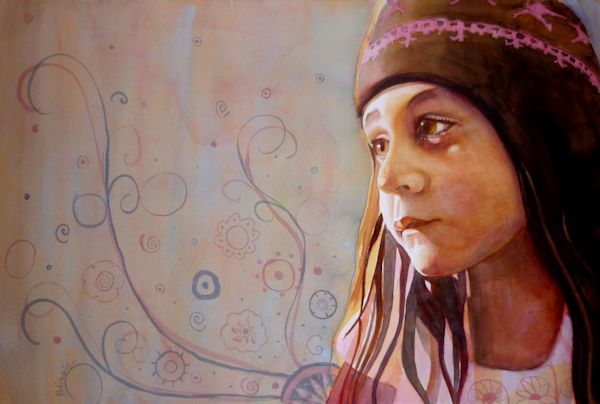This is especially true for portrait painters.
When painting portraits from photographs, the subject does not have to pose for so long, and the camera allows the artist to capture of fleeting moments that would be impossible to maintain for a long time with sittings. Using photographs also makes it easier to paint portraits of children. Even though nothing will beat the exercise of drawing from life, and using photographs to paint portraits remains a controversial topic in the art world, many famous artists, including Chuck Close, Picasso, Degas and Frida Kahlo, did work from photographs to paint portraits.Here are 5 tips to follow when painting portraits from photographs.
1. When taking pictures, take many of them and pay attention to distance and cropping.
If you crop too far, your portrait will be too small, lost in the background and you might be missing important information. If you crop too close, you might lose the balance background/foreground. “I wish it would snow flowers” by Sandrine Pelissier
“I wish it would snow flowers” by Sandrine Pelissier
2. Pay attention to lighting so you can gather sufficient information from your pictures.
Lighting is very important to see shapes. It’s preferable to use a single light source or natural light. Good lighting means you can see a wide range of tonal variations on the portrait. This is easier to see in a black and white version of your picture. Ideally, you will have many different tones of gray ranging from white to black. My advice is to not use a flash, as it tends to flatten all the shapes. A simple, uncluttered background will help to see the face more clearly. And it’s always a good idea to use the white balance setting on your camera to take into account the color temperature of your light source. Below you will see the black and white reference picture for my “I wish it would snow flowers” portrait seen above. I did “erase” the background on a picture editing software, as it was too distracting. The picture was taken with a single light source so I would have defined shades on the face.
3. Work from your own photos whenever it is possible.
You will avoid copyright issues and it makes it easier to paint your own vision of the world. This, of course, becomes more challenging when painting self-portraits from photographs. You may want to ask a friend to take a photo of yourself when painting a self-portrait.
Watercolor and mixed media by Sandrine Pelissier
4. Use the photograph as a starting point rather than try to replicate it.
It’s easy to get lost in the details when working from photographs. If you are not looking for a hyper photo-realistic style, you don’t have to paint everything you see in the picture. Likeness in a portrait resides more in the way the light is falling on the bone structure than in tiny details. You are not trying to reproduce the medium of photography but rather to use it as a starting point to express your own vision of the world.5. Remember also that photography is not an exact replica of reality.
Colors might come up a bit different, textures can look simplified, and shades and dark colors will often appear quite a bit darker than in real life. These are all factors to consider when working from photographs.
Master the art of painting portraits with help from Craftsy! Check out our classes Portraits in Watercolor with Matt Rota and Narrative Portraiture: Painting in Acrylic with Micah Ganske.

Share tips, start a discussion or ask one of our experts or other students a question.
No Responses to “5 Tips for Painting Portraits From Photographs”